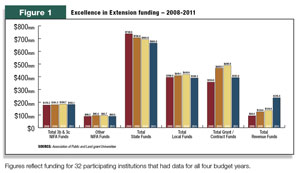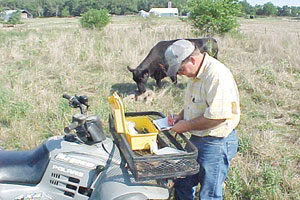Due to the lagging economy and thin tax revenue, many state legislatures have been forced to downsize government programs – and university extensions are among the first to feel the cut.
The trend isn’t just building in urban states, but in some of the nation’s largest ag production states.
■ South Dakota State University extension system’s budget has been cut three straight years to a total of 20 percent cuts in staff and funding. That forced the extension program to consolidate all its county extension programs into regional centers.
■ Iowa State Extension Service, one of the oldest in the country, did the same thing in 2009 after being forced to cut 92 county extension directors – and restructure into 20 regional extension directors.
■ Texas AgriLife Extension Service also saw a 10 percent cut, equaling 180 positions lost through a variety of moves as part of its just-completed two-year budget appropriation.
Texas AgriLife’s budget for the current biennium (2012-2013) is 15.3 percent less than the start of the last biennium, according to Pete Gibbs, associate director for state programs.
“You look across the board at all extension programs, and we’ll be a little leaner than we have been,” said Eldon Cole, an extension livestock specialist for the University of Missouri Extension.
“We’re seeing less money coming from federal agencies, less from the state, and many of our counties are hanging on a flat line.”
Four-year data collected by the Association of Public and Land-grant Universities from 32 institutions for the Excellence in Extension database reflect those same trends.
Figures reported between 2008 and 2011 showed a nearly 10 percent drop in total state funds over that three-year span for those reporting schools.
 Local funding sources and revenue from the USDA’s National Institute for Food and Agriculture, a large source of federal funding for extension, has also flattened. (See Figure 1.)
Local funding sources and revenue from the USDA’s National Institute for Food and Agriculture, a large source of federal funding for extension, has also flattened. (See Figure 1.)
The restructuring cuts in Texas were phased in over the summer, just as producers in that state were fighting through last summer’s staggering drought.Gibbs said those shifts created more work for the remaining agents.
“Our network of county extension agents backstopped by subject matter specialists, in this case beef cattle and forage specialists, is in place but with fewer people covering the responsibilities,” he wrote in an e-mail.
“If we have a noticeable gap at all right now, it would be in central Texas, as pertains to cattle, but we are working hard to keep it as unnoticed as possible.”
For Tom Field, executive director of producer education for the National Cattlemen’s Beef Association, the cuts to research and extension were foreseen by various industry committees a few years ago.
Politics began taking a larger toll on research infrastructure, he said. Today’s state legislators, especially those from non-ag states, tend to question the need for experimental stations.
Such moves shrink research capacity and create a global disadvantage for producers.
The result for many schools could lead to many changes on the horizon.
“We need a clear and candid discussion,” Field said. “Do we need to restructure or look at different models for the future?
The land grant university is still the best idea of democracy, but does every state need a research facility in every commodity? Are there ways to share facilities or models?”
South Dakota State Extension was forced to answer that question due to its string of cuts into extension programs.
A long analysis of services and customer demand led to a significant restructuring that unfolded in late 2011. Barry Dunn, dean of agricultural and biological sciences at South Dakota State University, said cuts in that state forced 66 county offices to consolidate into the five regional centers.
That restructuring toward regional offices and digital learning, he believes, is necessary since the “place-bound, person-bound system” in extension was not financially viable and was growing functionally obsolete.
Producers have already adapted to modern systems of information delivery, Dunn said, whether through their smartphones, computers or digital conference uplinks.
“Knowledge isn’t held by a place or person,” he explained. “Knowledge is everywhere; information is everywhere. So we needed to change anyway.
“Rather than being the expert-driven model that all knowledge resides at the county courthouse with the county agent, that’s not how the world works. These budget cuts have been a way to transition us to a new world.”
Sandy Johnson, a livestock specialist at Kansas State University, echoed that sentiment. “In some ways, I don’t think our extension has changed nearly as much as agriculture,” she said. “I don’t know if it needs to, but at times, it bothers me whether or not we’re keeping up with the changes going on.”
Extension restructuring doesn’t just affect producers, Johnson said, but also “anybody that eats.”
“The system that has built agriculture in our country is the envy in many other countries,” she said. “If we totally allow it to go away and find we were wrong in doing so … it won’t be recreated overnight, because part of it is the establishment of relationships and developing a presence in your community.”
But local support at some extension networks remains a viable source, since many universities recognize the connection to agricultural producers defines their mission.
Many county governments adopt the same philosophy and remain committed to strong extension offices.
Cole said county offices in Missouri have provided support by statute, but regional offices are also a long part of the institutional tie to state agriculture.
“It is a workable position for us; we’ve grown up with that system and we are adapting a little more easily than other states would,” he said.
But with revenue tight, Cole said producers should expect their local extension office to be more direct about generating revenue for services they offer producers.
“In the past, it’s been a given it’s not going to cost to attend (an event),” he said. “We need to get a little more serious about covering education expenses. And we’re going to have to get some innovative ways to generate income.” ![]()
Staff writer Tony Okon contributed to this article.
PHOTO:
Top Righty: An extension agent helps fill out the field paperwork for an age and source program. Extension agent offices around the country are looking at restructuring due to federal and state cuts. Photo courtesy of University of Missouri Extension.








